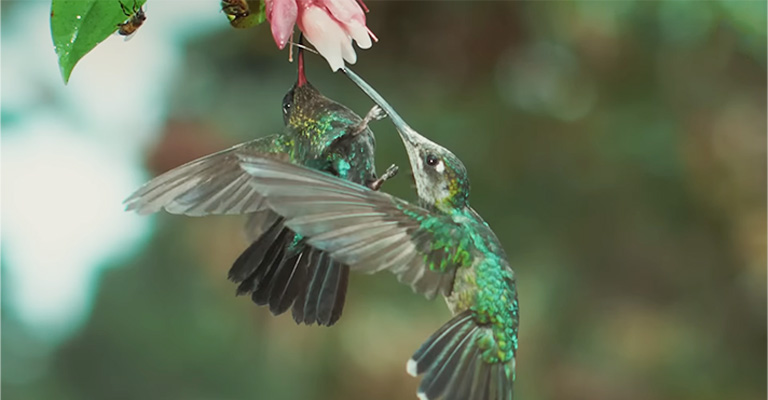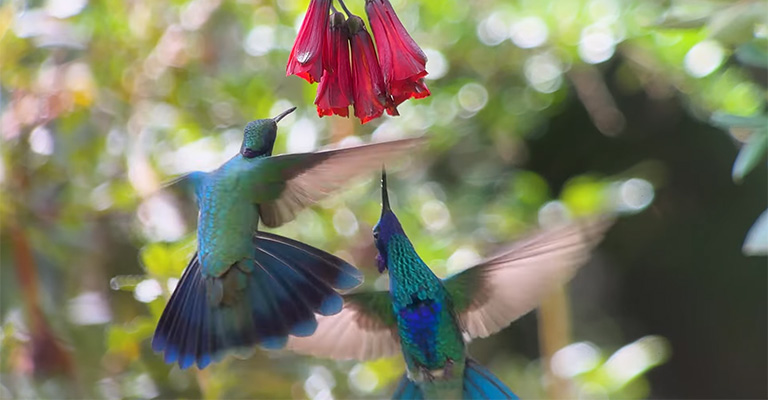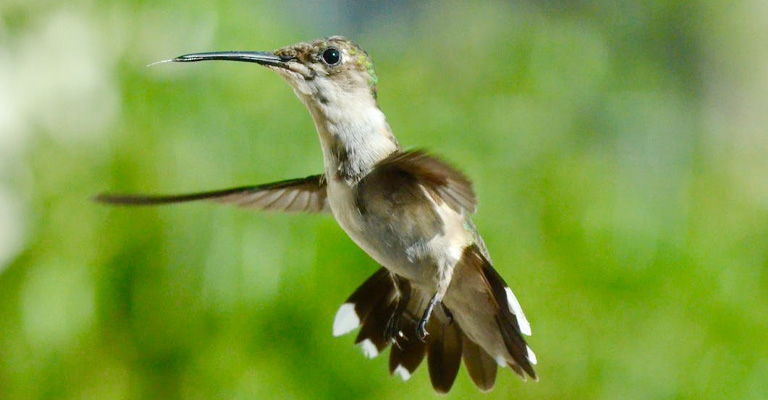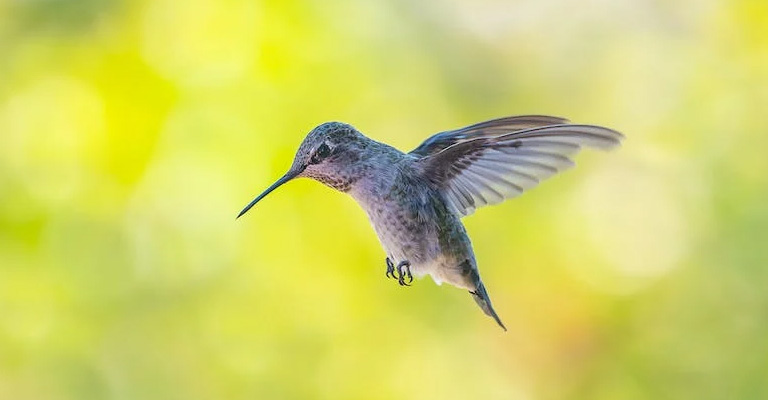Hummingbirds, with their vibrant plumage and delicate appearance, have long captivated the imagination of bird enthusiasts.
These tiny creatures, known for their remarkable hovering abilities and swift movements, are often associated with grace and beauty.
However, there is a lesser-known side to these avian wonders that has piqued the curiosity of researchers and birdwatchers alike: their aggressive behavior.
So, do hummingbirds attack? Contrary to popular belief, hummingbirds are not always gentle and peaceful. In fact, they can be quite territorial and fiercely defend their feeding and nesting areas.
This intriguing aspect of their behavior raises questions about the reasons behind their aggression and the extent to which they engage in attacks.
In this article, we will delve into the fascinating world of hummingbird aggression. We will explore the factors that trigger their territorial behavior, the tactics they employ to defend their territories, and the potential consequences of their attacks.

Do Hummingbirds Attack?
Yes, hummingbirds can be quite territorial and may exhibit aggressive behavior towards other hummingbirds, especially during mating season or when defending their feeding territories.
They may engage in aerial chases, dive-bombing, or even physical contact to establish dominance or protect their resources. However, it’s important to note that hummingbirds are generally small and their attacks are not harmful to humans.
Why Do Hummingbirds Attack?

When it comes to hummingbird aggression, it primarily occurs between males competing for territory or mates. Here are some additional details:
Territory Defense
Male hummingbirds establish feeding territories and vigorously defend them against intruders. They will chase away any other hummingbirds that enter their claimed area.
Aerial Displays
During territorial disputes, hummingbirds engage in impressive aerial displays. This can involve high-speed chases, zigzag flights, and sudden direction changes. They may also emit vocalizations to assert dominance.
Dive-Bombing
In some cases, a dominant hummingbird will dive-bomb an intruder, swooping down from above and attempting to make physical contact. This behavior is meant to intimidate and drive away the rival.
Physical Contact
While rare, physical contact between hummingbirds can occur during aggressive encounters. This can involve grappling, pecking, or even brief skirmishes in mid-air. However, these interactions are typically brief and not intended to cause harm.
Mating Season
During the breeding season, male hummingbirds become particularly territorial and aggressive. They defend their chosen territory, which often includes a prime feeding area, to attract females for mating.
Display Flights
Male hummingbirds perform elaborate aerial displays to attract females and establish dominance. These displays involve flying in U-shaped patterns, diving, and making rapid wing sounds to impress potential mates and intimidate rivals.
Vocalizations
Hummingbirds use vocalizations as a form of communication during aggressive encounters. They emit high-pitched chirps, trills, or chattering sounds to assert dominance or warn off intruders.
Size and Speed
Hummingbirds are known for their small size and incredible agility. Their rapid wing beats allow them to hover, fly backwards, and change direction quickly. This agility helps them in territorial disputes, as they can maneuver swiftly to defend their space.
Species Differences
Different hummingbird species may exhibit varying levels of aggression. Some species are more territorial and aggressive than others.
For example, the Rufous Hummingbird is known for its highly aggressive behavior, while others, like the Ruby-throated Hummingbird, may be less confrontational.
It’s important to remember that hummingbirds are generally harmless to humans. Their aggression is primarily directed towards other hummingbirds and is a natural part of their behavior.
Enjoy observing these fascinating creatures from a safe distance and provide them with a welcoming environment by offering nectar feeders and native plants.
Why Do Hummingbirds Fly Up to Your Face?

Hummingbirds are known for their agility and curiosity, and their behavior of flying up to your face can have several possible explanations:
Curiosity
Hummingbirds are naturally curious creatures and may be intrigued by human activity or objects. When they see movement or something shiny, they may investigate it by flying up close, including up to your face.
Territory Defense
Male hummingbirds are known to be territorial and may perceive your presence as a potential threat to their territory or food sources. Flying up to your face could be a display of territorial defense, warning you to stay away.
Feeding Behavior
Hummingbirds are attracted to bright colors, including the colors of flowers and clothing. If you are wearing bright colors or have flowers nearby, they may mistake you for a potential food source and fly up to investigate.
Mating Behavior
During the breeding season, male hummingbirds may engage in courtship displays to attract females. Flying up to your face could be a part of their mating behavior, as they try to impress potential mates or establish dominance.
Reflections
Hummingbirds are attracted to reflective surfaces, as they resemble the shimmering of flower petals. If you are wearing jewelry or have reflective objects nearby, they may be drawn to the reflections and fly up to investigate.
It’s important to note that hummingbirds are wild animals and their behavior can vary. Enjoy their presence and observe them from a respectful distance, allowing them to go about their natural behaviors without disturbance.
How to Prevent Hummingbird Attacks?

Hummingbird attacks are rare and usually occur when they feel threatened or perceive a potential threat to their territory or food sources. Here are some tips to help prevent hummingbird attacks:
Maintain Distance
When observing hummingbirds, it’s important to maintain a respectful distance. Avoid getting too close to their nests, feeding areas, or perching spots. Give them space to feel comfortable and safe.
Avoid Bright Colors
Hummingbirds are attracted to bright colors, so it’s best to avoid wearing bright clothing or accessories that may attract their attention. This can help minimize their curiosity or mistaken identity.
Provide Multiple Feeding Stations
If you have hummingbird feeders in your yard, consider placing them at different locations. This can help prevent overcrowding and reduce competition among hummingbirds, which can sometimes lead to aggressive behavior.
Create Natural Barriers
Planting dense shrubs or trees around your hummingbird feeders can create natural barriers and hiding spots. This can help reduce the visibility of the feeders from a distance, making them less likely to attract aggressive hummingbirds.
Be Mindful of Nesting Areas
Hummingbirds are protective of their nests and may become more aggressive if they feel their young are threatened. Be aware of their nesting areas and avoid disturbing them.
Do Hummingbirds Attack Humans?

Hummingbirds are not known to intentionally attack humans. However, they can sometimes exhibit territorial behavior, especially during their breeding season.
Male hummingbirds are particularly territorial and may defend their feeding and nesting areas vigorously against other birds, including other hummingbirds and larger birds.
These territorial displays can sometimes be mistaken for aggression towards humans, but in reality, the hummingbirds are just trying to establish and protect their territory.
Such displays might involve swooping flights, rapid buzzing sounds, and occasional dives to deter perceived intruders. Keep in mind that these interactions are generally not harmful to humans.
Hummingbirds are tiny creatures, and their beaks are adapted for feeding on nectar from flowers. Their beaks are not designed for attacking or causing harm to larger animals.
What Other Animals Do Hummingbirds Attack?
Hummingbirds are known to be territorial and may engage in aggressive behaviors towards other animals, particularly other hummingbirds and insects. Here are a few examples of animals that hummingbirds might show aggression towards:
Other Hummingbirds
Within their territories, male hummingbirds are especially aggressive towards other males of the same species. They engage in aerial displays, rapid flights, and sometimes physical interactions like chasing and even brief physical contact.
Insects
Hummingbirds are primarily nectar feeders, but they do consume insects and spiders for protein. They might chase away insects that come too close to their feeding areas or even catch them mid-air.
Larger Birds
While hummingbirds might not directly attack larger birds, they could display aggressive behavior towards them if they perceive them as a threat or an intruder. This behavior is more about defending their territory than actively attacking.
Animals Approaching Nests
When it comes to protecting their nests and young, hummingbirds can become more aggressive. They might chase away squirrels, lizards, or other small creatures that approach their nesting sites.
FAQs
Hummingbirds have long, specialized bills and extendable, tube-like tongues that allow them to extract nectar from flowers.
They hover in front of flowers, using their rapid wing beats to maintain a stationary position while they insert their tongues into the nectar-rich blossoms.
While nectar is their primary food source, hummingbirds also consume insects and spiders for protein. They catch insects mid-air or pluck them from leaves and spider webs.
Many hummingbird species undertake long migratory journeys to find suitable breeding and feeding grounds. They migrate to areas with more abundant flowers and insects during the warmer months and return to warmer climates during colder months.
The wing beats of hummingbirds can vary depending on the species, but they typically range from around 50 to 80 beats per second. This incredible wing speed allows them to hover and maneuver with precision.
Hummingbirds are important pollinators for various flowering plants. As they feed on nectar, their heads come into contact with the reproductive parts of flowers, transferring pollen from one bloom to another and facilitating the fertilization process necessary for plant reproduction.
Parting Thoughts
In the enchanting realm of nature, where vibrant colors and delicate wings intertwine, hummingbirds emerge as fierce warriors of the sky.
With astonishing agility and unwavering determination, these tiny avian marvels embark on daring quests to protect their territories.
Their beaks, like swift swords, pierce the air as they defend their nectar-rich domains from intruders. With lightning-fast maneuvers, they engage in aerial battles, their wings humming a battle cry.
Yet, amidst their warrior spirit, these captivating creatures also embody grace and beauty, their iridescent feathers shimmering like precious gems.
As the sun sets on their valiant endeavors, the hummingbirds remind us of the indomitable spirit. In their world, where battles are fought with elegance, they teach us that true strength lies in the courage to protect what we hold dear.